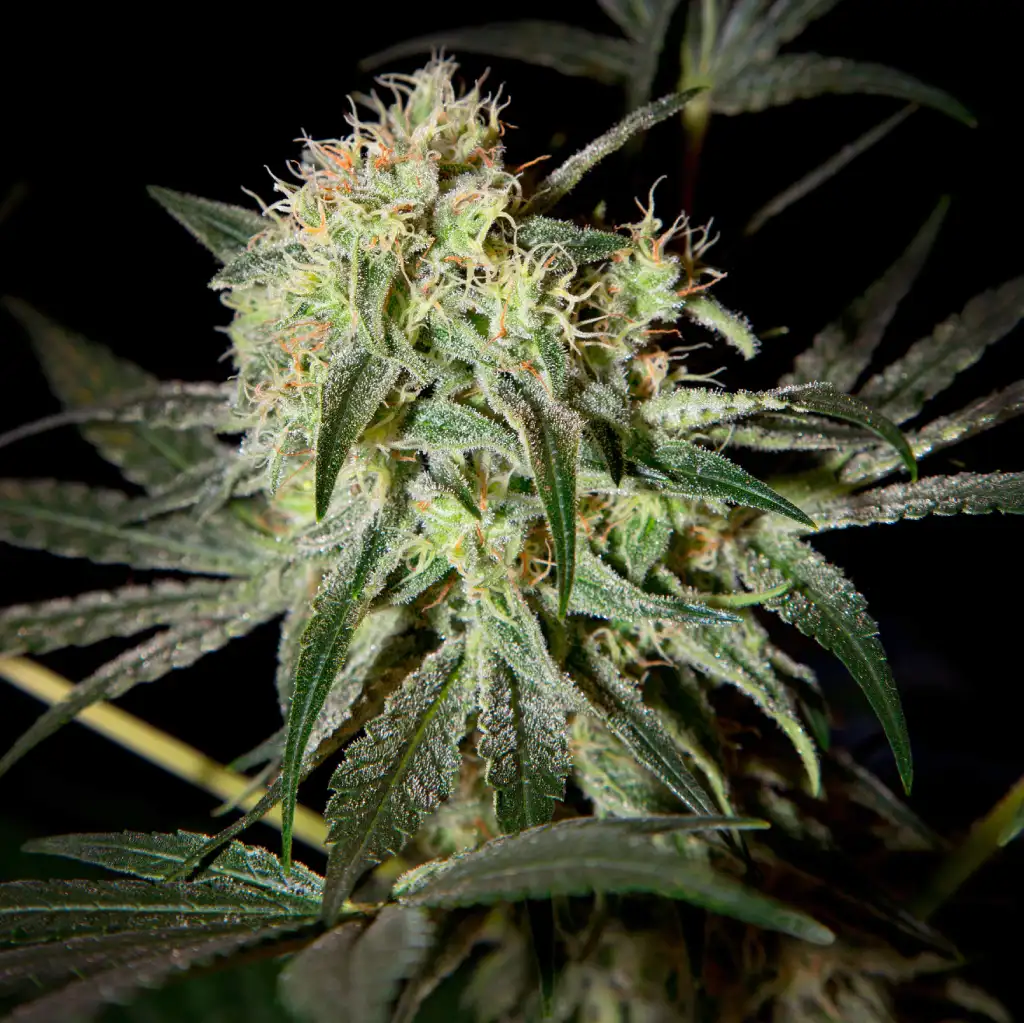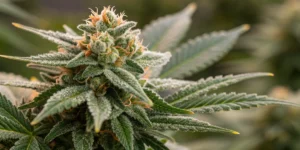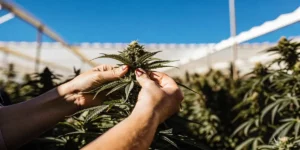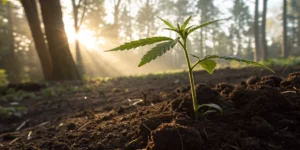The Damn Sour strain is known for its intense flavor profile, delivering a unique combination of tangy and earthy notes that satisfy experienced cannabis enthusiasts. This strain has gained popularity for both recreational and medicinal use, and understanding how to grow it successfully can make a big difference in your harvest. Below, we’ll explore all the essentials for growing Damn Sour, from its environmental needs to its week-by-week growth journey.
Damn Sour Strain Description
Damn Sour is a hybrid strain that offers a well-balanced experience, combining both uplifting effects with a calming body high. Its genetic background traces back to Sour Diesel, giving it its signature pungent aroma, while other undisclosed hybrids contribute to its unique structure and growth characteristics. This strain is known for its high THC content, making it suitable for those looking for potent effects. The buds are dense, covered with sticky trichomes, and release a powerful, sour aroma that distinguishes Damn Sour from other cannabis varieties.
The Damn Sour strain can be recognized by its vibrant green color, with purple hues appearing under cooler temperatures during the late flowering phase. Its terpene profile is dominated by limonene, caryophyllene, and myrcene, providing an unmistakable citrusy sour scent with earthy undertones. This combination results in a rich flavor experience that has made Damn Sour a favorite for both recreational and medicinal consumers.
Environmental Requirements for Growing Damn Sour Strain
Growing Damn Sour successfully requires an optimal environment that encourages healthy development. Like most cannabis strains, Damn Sour thrives in environments with moderate humidity and a stable temperature range between 70°F and 85°F (21°C to 29°C). Humidity should be kept lower during the flowering phase to prevent mold development, ideally dropping from 60% during the vegetative phase to around 40% as buds start to form.
Lighting plays a crucial role, especially for indoor growers. Damn Sour responds well to high-quality LED lights that provide full-spectrum light. Outdoors, this strain enjoys ample sunlight, so choose a location that receives at least 8 hours of direct sunlight each day. The ideal soil pH for Damn Sour is slightly acidic, between 6.0 and 6.5, to facilitate nutrient uptake and optimal growth.
Setting Up The Growing Cannabis Space
Setting up the right environment is key to maximizing your Damn Sour harvest. For indoor growers, a grow tent or a dedicated grow room with reflective walls helps ensure that your plants receive adequate light exposure. Good ventilation is also essential to maintain a consistent environment and to prevent mold.
Install fans to ensure proper airflow throughout the grow space, which helps strengthen plant stems and prevents stagnant air. A carbon filter may also be necessary to manage the strong odor that Damn Sour produces, especially during the flowering phase. Outdoor growers should consider climate and soil conditions carefully, aiming to provide an environment similar to what Damn Sour needs indoors, ensuring adequate sunlight and airflow.
Indoor Cannabis Cultivation
Cultivating Damn Sour indoors allows for precise control over the growing conditions, which is beneficial for maximizing yields. Hydroponic systems can be used, but growing in soil is recommended for this strain, as it helps develop the rich flavors that Damn Sour is known for. Utilize LED grow lights that provide full-spectrum light, and make sure the light cycle is maintained at 18/6 (light/dark) during the vegetative stage, switching to 12/12 for flowering. For fans of bold, sour profiles, Sour Kush Autoflower is another excellent option to consider, offering ease of growth and strong effects in a compact format.
Indoor growers must pay close attention to nutrient schedules. During the vegetative phase, a nutrient mix high in nitrogen will help with vigorous growth, while during the flowering stage, potassium and phosphorus become more important. Pruning and training, such as low-stress training (LST), can help direct energy to the buds and improve overall yields.
Outdoor Cannabis Cultivation
Growing Damn Sour outdoors works well in climates with warm temperatures and plenty of sunshine. This strain is resilient, but outdoor growers must ensure the environment is free from pests and extreme weather conditions. Choosing an area with rich, well-draining soil and adequate sun exposure will allow the plants to thrive.
Since outdoor plants are more exposed, regular inspections for pests or mold are essential. Damn Sour typically reaches maturity in late September to early October, depending on the local climate. It can grow quite tall when grown outdoors, so make sure you provide enough space for the plant to reach its full potential.
Propagation and Germination of Damn Sour Strain
Propagation is the first step in growing Damn Sour. Germination typically starts with soaking the seeds in water for 24 hours to initiate sprouting. Once the seeds show a small taproot, they can be transferred to a moist paper towel or directly into the growing medium.
Damn Sour seeds usually germinate within 3 to 5 days, at which point they are ready for planting. Maintaining a stable temperature of around 75°F (24°C) and keeping the environment humid will give the seeds the best chance of sprouting quickly. During this early stage, gentle handling is crucial to avoid damaging the taproot.
Vegetative Phase of Damn Sour Strain
Once germinated, Damn Sour enters the vegetative phase. This is when the plant establishes its root system and develops its leaves and stems. During this phase, providing a nutrient mix high in nitrogen is key to promoting rapid growth.
The vegetative phase is also the ideal time to start training techniques like topping or low-stress training (LST). These techniques help control the plant’s height, encourage lateral growth, and ultimately lead to higher yields by allowing more light to penetrate the canopy. Keep humidity around 60% and maintain a temperature between 70°F and 80°F (21°C to 27°C) for optimal growth.
Flowering Phase of Damn Sour Strain
The flowering phase is when Damn Sour truly begins to show its unique characteristics. This phase is triggered when the light cycle is switched to 12 hours of light and 12 hours of darkness for indoor growers. Outdoor plants will naturally transition as the days shorten towards autumn.
The flowering phase lasts around 8 to 9 weeks. During this period, reduce the humidity to 40-50% to prevent mold, particularly as the buds become dense and sticky. Provide nutrients rich in phosphorus and potassium to enhance bud production, while gradually reducing nitrogen to avoid leafy growth. The buds will grow thick and become covered in trichomes, emitting a potent aroma that signifies the strain’s high THC content.
Cannabis Fertilization and Nutrition – Damn Sour Strain
Damn Sour requires a balanced nutrient regimen throughout its life cycle. During the vegetative stage, a high nitrogen fertilizer supports strong leaf and stem growth, while during the flowering phase, a blend high in phosphorus and potassium ensures robust bud formation.
Micro-nutrients such as calcium and magnesium are also essential, especially when using filtered water, which may lack these nutrients. Avoid overfeeding, as Damn Sour is somewhat sensitive to nutrient burn, which can result in curled leaf tips and discoloration. Flushing the plant with clean water during the final weeks before harvest can help remove excess nutrients, enhancing the smoothness of the final product.
Pest and Disease Control for Cannabis Growing
Growing Damn Sour requires consistent vigilance against pests and diseases. Due to its dense buds and vigorous growth, this strain can be prone to mold and certain pests like spider mites and aphids.
Prevention
Prevention is always better than cure. Maintaining a clean grow space, ensuring proper airflow, and avoiding overwatering are key strategies to prevent mold and pests. Companion planting with herbs like basil or mint can help deter pests naturally, especially when growing Damn Sour outdoors.
Corrective Actions
If pests are detected, take immediate action. Natural insecticides such as neem oil or insecticidal soap can be effective. For indoor growers, using beneficial insects like ladybugs can also help control pest populations without harmful chemicals. In the case of mold, removing affected areas and reducing humidity are crucial steps.
Harvesting and Curing for Cannabis Growing
Harvesting Damn Sour is all about timing. The best time to harvest is when the trichomes have turned from clear to milky, with some amber heads for a more relaxing effect. Cut the plant at the base and hang it upside down in a dark, well-ventilated space to dry for about 10-14 days.
Once dried, the buds should be cured in glass jars, opening them daily for the first week to allow moisture to escape. Proper curing enhances the flavor, potency, and smoothness of the smoke, making Damn Sour even more enjoyable.
Is Damn Sour Indica or Sativa?
Damn Sour is a hybrid strain, leaning slightly towards the Sativa side. It provides an uplifting cerebral high paired with a relaxing body effect, making it ideal for daytime use when focus and creativity are needed. Its genetic background gives it the best of both worlds, with the energizing properties of Sativa and the soothing qualities of Indica.
Advantages of Growing Damn Sour Strain
One of the biggest advantages of growing Damn Sour is its resilience. This strain is known for its adaptability, able to thrive in both indoor and outdoor settings as long as its basic environmental needs are met. Its high yield potential makes it a rewarding choice for both beginner and experienced growers.
In addition, the unique flavor profile of Damn Sour, combined with its potent effects, makes it highly desirable. The dense, sticky buds are packed with trichomes, which not only contribute to its potency but also make it great for producing extracts like hash or rosin.
Problems in Cultivating Damn Sour Strain
Growing Damn Sour, like any cannabis strain, can come with its own set of challenges. Understanding these problems beforehand allows you to take the necessary steps to prevent them. One of the common issues growers face with Damn Sour is its sensitivity to humidity. During the flowering stage, high humidity can lead to mold development, particularly within the dense buds. It’s crucial to maintain proper ventilation and keep humidity levels under control to avoid this.
Another challenge is nutrient sensitivity. Damn Sour is known to react negatively to overfeeding, especially during the flowering phase. Signs of nutrient burn include yellowing leaves and brown spots along the edges. To avoid this, it’s best to follow a “less is more” approach when adding fertilizers. A consistent feeding schedule with adequate but not excessive nutrients is key to avoiding these issues.
Advanced Pest Control for Cannabis Growing
Pest control is an ongoing task when cultivating Damn Sour, as the pungent aroma can attract unwanted pests. While prevention is crucial, advanced pest control strategies are often necessary to keep your plants healthy. Integrated Pest Management (IPM) is one of the best approaches to controlling pests without harming your plants or the environment.
IPM combines biological, cultural, and mechanical practices to control pests. Introducing beneficial insects like predatory mites can effectively reduce populations of harmful bugs like spider mites. Neem oil and insecticidal soaps are also excellent for controlling aphids and thrips, two common pests that can target cannabis plants.
Similar Strains
If you enjoy growing Damn Sour, there are several other strains you might find interesting. Sour Diesel is a close relative and shares the same powerful, uplifting effects paired with a pungent, diesel-like aroma. For those looking for something with a more indica-dominant feel, Super OG Kush is an excellent choice, offering a similar flavor profile but with a more relaxing, body-heavy high.
Another strain to consider is Amnesia Haze Auto , which provides a similar energetic boost and citrus-like flavor, although it tends to be slightly more forgiving when it comes to environmental requirements. If you’re interested in exploring different hybrids with sour and tangy flavors, these strains are all excellent alternatives to Damn Sour.
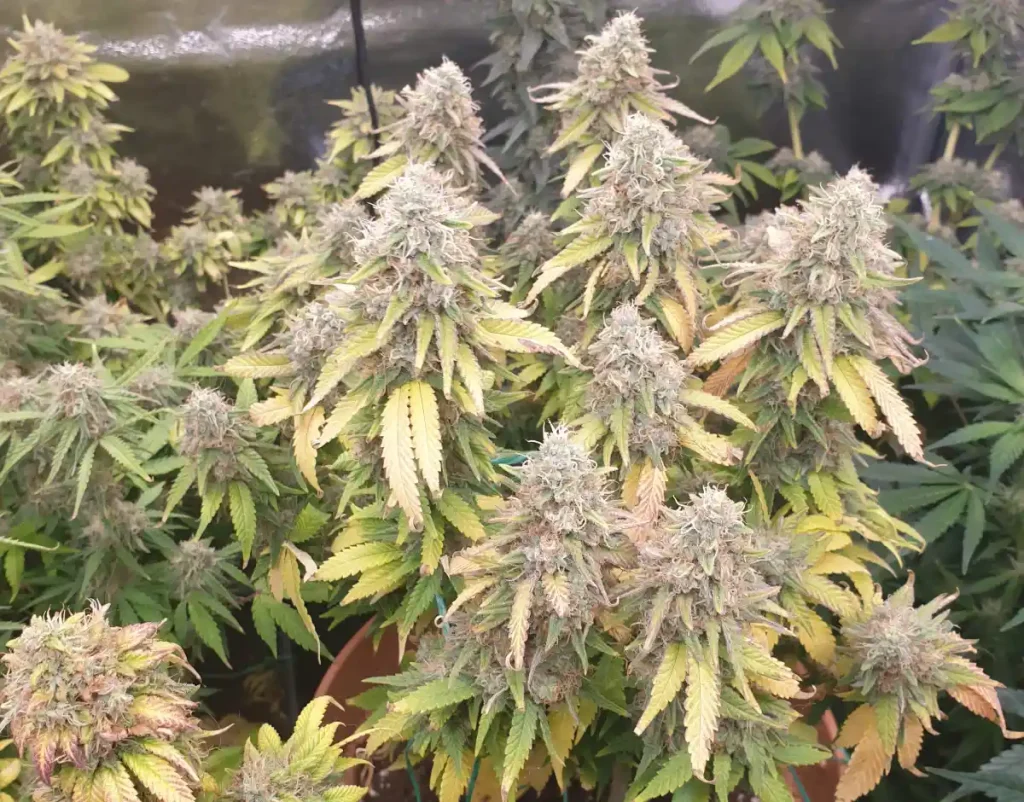
Week-by-Week Growth Plan
Week 1 – Germination and Seedling Stage
In the first week, focus on germinating your Damn Sour seeds. Start by soaking them in water for 24 hours before transferring them to a damp paper towel. Keep them in a dark, warm place until the seeds sprout. Once they develop small taproots, transfer them to the growing medium. Maintain humidity levels around 70% to encourage root development, and keep the temperature at about 75°F (24°C).
Week 2 – Early Seedling Growth
During the second week, the seedlings will begin to develop their first set of true leaves. Keep the humidity high at around 65-70% and continue to maintain temperatures between 70-75°F (21-24°C). Provide low-intensity light at this stage, either from an LED grow light or natural sunlight if growing outdoors. Be cautious with watering—keeping the soil moist but not too wet is crucial to avoid damping-off disease.
Week 3 – Seedling Development Continues
By the third week, your seedlings should be showing more sets of leaves. This is a good time to start adding a diluted nutrient solution high in nitrogen to support leaf development. Make sure the plants are getting 18 hours of light each day. Monitor soil moisture carefully, and begin gently introducing airflow with a small fan to strengthen the stems.
Week 4 – Vegetative Growth Begins
In the fourth week, your Damn Sour plants enter the vegetative phase. This is when they will start putting on height and leaf mass. Increase your nutrient dosage gradually, focusing on nitrogen for healthy vegetative growth. If you haven’t already, now is the time to transplant your plants into larger containers to allow more root growth.
Week 5 – Accelerated Vegetative Growth
The fifth week is marked by rapid vegetative growth. Continue providing 18/6 light cycles and ensure the plant is getting ample nitrogen. Training techniques like low-stress training (LST) can help promote more bud sites by encouraging lateral growth. Humidity should be reduced slightly to around 60%, and the temperature should remain stable.
Week 6 – Preparing for Flowering
By the sixth week, Damn Sour will continue expanding, and you should notice a strong aroma developing. Begin preparing for the flowering phase by reducing nitrogen levels slightly and increasing potassium. Keep trimming lower branches to improve airflow and focus energy on the top growth. The plant should be well-established by now, with strong stems and healthy foliage.
Week 7 – Transition to Flowering
Week seven is when you begin transitioning your light cycle to 12 hours of light and 12 hours of darkness for indoor grows. Outdoor growers will start noticing natural changes as the days get shorter. The plant will stretch during the first two weeks of flowering, so ensure there is enough vertical space to accommodate the growth spurt.
Week 8 – Early Flowering
In the eighth week, buds will start to form, and you’ll see white pistils appearing. Increase phosphorus and potassium to encourage bud production, and keep the humidity at around 50% to prevent mold. The aroma will become stronger, so make sure your ventilation system is functioning well if you’re growing indoors.
Week 9 – Mid-Flowering
During the ninth week, buds will begin to thicken and develop more trichomes. Reduce nitrogen levels and focus on phosphorus-rich nutrients to maximize bud growth. Humidity should be dropped to 45%, and continue monitoring for pests or mold. The plant will need adequate airflow to keep moisture away from the developing buds.
Week 10 – Bud Development
By week ten, the buds should be growing larger and denser. You may start to see trichomes turning milky, indicating the production of cannabinoids. At this point, the Damn Sour strain’s signature aroma will be at its peak. Maintain stable temperatures and ensure the plant isn’t overfed, as nutrient burn can harm bud quality.
Week 11 – Late Flowering
During the eleventh week, you’ll notice the pistils on your buds changing color from white to orange. The trichomes will also start turning from milky to amber, indicating that harvest time is approaching. Start flushing your plants with pure water to remove any residual nutrients, which will improve the flavor and quality of the buds.
Week 12 – Harvesting Time
By week twelve, Damn Sour is ready to harvest. Look for milky and some amber trichomes as a sign that the buds are at their peak potency. Harvest the plants, trim the fan leaves, and hang the branches upside down in a dark room to dry. Ensure there is good airflow but avoid direct fans, as they can dry out the buds too quickly.
Week 13-14 – Curing the Buds
After the buds have dried for about 10-14 days, place them in glass jars to cure. Open the jars daily for the first week to let moisture escape, then gradually reduce the frequency. Proper curing takes at least 3 weeks and helps improve both the flavor and potency of Damn Sour.
FAQs About Damn Sour Strain
What is the THC percentage of Damn Sour?
Damn Sour typically has a THC content ranging between 18-22%, making it a potent strain suitable for both recreational and medicinal use. The exact percentage can vary depending on growing conditions and care provided during cultivation.
How long does it take for Damn Sour to flower?
The flowering phase for Damn Sour lasts approximately 8-9 weeks. This timeframe can vary slightly depending on environmental conditions and whether the plant is grown indoors or outdoors.
What flavors and terpenes are present in Damn Sour Strain?
Damn Sour boasts a terpene profile rich in limonene, caryophyllene, and myrcene. These terpenes give it a tangy, citrusy flavor with earthy undertones, resulting in a complex and enjoyable smoke.
Can Damn Sour be grown both indoors and outdoors?
Yes, Damn Sour can be grown in both indoor and outdoor environments. Indoor growers benefit from having control over environmental conditions, while outdoor growers can take advantage of natural sunlight to maximize growth.
What are the medicinal benefits of Damn Sour Strain?
Damn Sour is known for its uplifting and stress-relieving effects, making it a popular choice for those looking to alleviate anxiety and depression. Its balanced hybrid nature also provides moderate pain relief without the heavy sedative effects of more indica-dominant strains.

